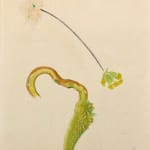


Joseph Stella American, 1877-1946
Sheet 11 x 12 1/4 inches
Further images
Early in his artistic training Joseph Stella showed a strong interest in studying flowers, something his teacher William Merritt Chase encouraged. Stella found inspiration for his drawings in fourteenth- and fifteenth-century Italian and Flemish painters, and, in 1919, he began creating numerous silverpoint and crayon sketches of flowers, insects, and birds. Stella associated his floral imagery with themes of passion and sensuality, writing in his notes, “I was seized with a sensual thrill in cutting with the sharpness of my silverpoint the terse purity of the lotus leaves or the matchless stem of a strange tropical plant.”[1]
[1] Joann Moser, Visual Poetry: The Drawings of Joseph Stella (New York: Smithsonian Institution, 1990), 113.
Join our mailing list
* denotes required fields
We will process the personal data you have supplied in accordance with our privacy policy (available on request). You can unsubscribe or change your preferences at any time by clicking the link in our emails.


